Best Time to Travel to the Isle of Skye: Essential Monthly Weather Guide
16 min readIf you’re pondering the best time to travel to the Isle of Skye and wanting to know Skye’s monthly weather, you have landed on the perfect spot. I have crafted...
The post Best Time to Travel to the Isle of Skye: Essential Monthly Weather Guide appeared first on Timeless Travel Steps.
If you’re pondering the best time to travel to the Isle of Skye and wanting to know Skye’s monthly weather, you have landed on the perfect spot. I have crafted this guide to satisfy your curiosity and aid in planning your visit.
The Isle of Skye, a beacon of natural beauty in Scotland, within the United Kingdom, invites adventurers, photographers, and nature lovers to immerse themselves in its landscapes, shaped by the elements and steeped in myth.
Whether you seek the warmth of the summer sun, the vivid colours of autumn, or the serene snow-capped tranquility of winter, understanding Skye’s monthly weather patterns is key to experiencing the island at its best.
Drawing from my own experiences and visits to the Isle of Skye, I offer insights into Skye’s ever-changing climate, and when to avoid the midges to help you pinpoint the best time for your unforgettable journey to this majestic isle. Not only do I offer an overarching guide to the island’s weather, but also a month-by-month guide to what to expect in temperatures. I have included all the weather-related information for you, so you need not look elsewhere. Read to the end of the article, so you benefit fully from this guide.
Timeless Travel Steps is supported by our readers. If you purchase through an affiliate link on my site, at no cost to you, I may earn a commission from qualifying purchases. Please read our Disclosure for further information.

Discovering the Isle of Skye, Scotland
Situated off the northwest coast of Scotland, the Isle of Skye is a breathtakingly beautiful part of the United Kingdom that beckons travellers with its unique blend of landscapes, history, and culture. Known for its rugged beauty, dramatic mountain ranges, and serene coastlines, Skye is not just a destination but an experience that stays with you long after you’ve left the magical isle.
This magical island, rich in myths and legends, offers an escape into nature where the land and sea meet under a canopy of shifting skies. Working out the best time to travel to the Isle of Skye is just as important as planning an ideal trip itinerary.
The allure of Skye lies in its diversity. From the majestic Cuillin Hills to the mystical fairy pools, ancient castles, and quaint fishing villages, there’s a story at every turn. Skye’s natural beauty is unparalleled, with its towering cliffs, cascading waterfalls, and iconic landmarks like the Old Man of Storr and Neist Point Lighthouse. The island’s wildlife is as captivating as its landscapes, offering sightings of eagles, otters, and red deer. Whether you’re a hiker, photographer, or someone seeking tranquility, Skye provides an enchanting backdrop for all.

The Best Time to Travel and Skye Weather Patterns
Skye’s Climate Overview and What to Expect
The weather in Skye is a significant part of its charm. The island’s climate is maritime, meaning it is influenced by the Atlantic Ocean, leading to mild winters and cool summers. However, Skye’s weather is famously changeable, with the possibility of experiencing all four seasons in a single day.
The average temperature fluctuates throughout the year, with warmer months from June to August and colder months from November to February. Rainfall is a constant companion, contributing to the lush landscapes and misty mornings that define Skye’s mystical ambiance.
Climate Nuances: From Average Temperature to Wind Speed
When planning a visit to the Isle of Skye, understanding the climate nuances is crucial. The average maximum temperature during the summer months hovers around 14-17°C (57-63°F), while in winter, it can drop to around 5-7°C (41-45°F).
Wind speed on the island can vary, often intensifying the perceived temperature, especially in exposed areas like cliff tops and coastal paths.
Despite the rain, Skye boasts many clear, bright days, particularly from April to June, when the island sees less rainfall and longer hours of sunshine. This period, between April and June highlights Skye’s weather at its best, with mild temperatures and the landscape bursting into life.
Skye’s weather patterns, from the average temperature to wind speed and rainfall, play a pivotal role in shaping the visitor experience. Embracing the island’s climate nuances can turn your trip into an adventure, revealing Skye in all its ever-changing beauty. Skye’s climate is as integral to the island’s character as its stunning landscapes and rich heritage.
PRO TIP: Investing in a high-quality windbreaker and adopting a layering approach to clothing is essential. Start with a moisture-wicking base layer, add an insulating middle layer for warmth, and finish with a windproof and waterproof outer layer to protect against the island’s unpredictable weather. In this way, you’re prepared for any condition, allowing you to fully immerse in Skye’s breathtaking landscapes without the weather slowing you down.
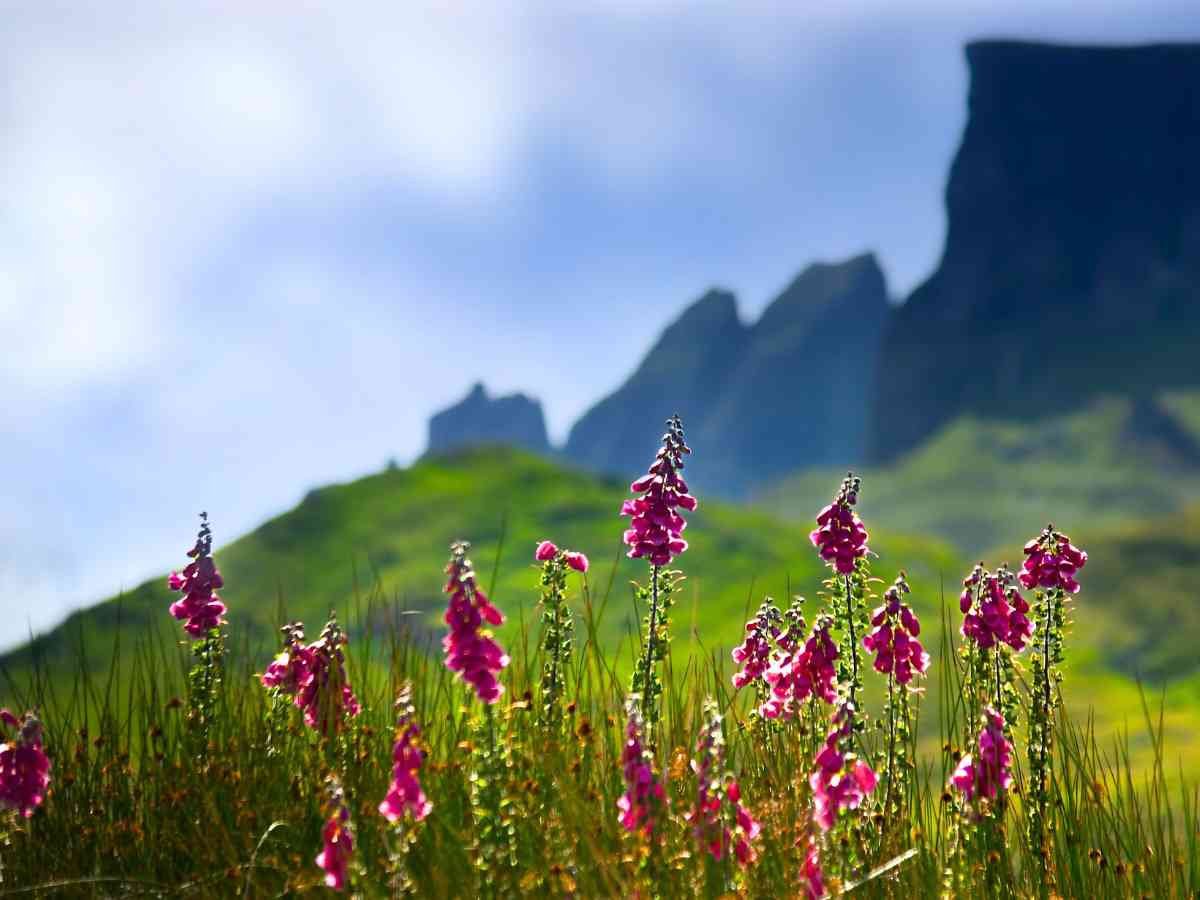
January and February: The Winter’s Quiet Majesty
Isle of Skye Weather in January
January on the Isle of Skye presents a quintessential winter tableau, with the mercury hovering between the brisk bounds of 3°C to 7°C (37°F to 45°F). During this month, the cold grips the landscape firmly, and the higher terrains may cloak themselves in a serene blanket of snow, transforming the island into a breathtakingly stark yet stunningly beautiful winter wonderland.
The days are short, with limited hours of sunlight piercing through the cold, casting a unique light over Skye’s dramatic scenery. This period offers an ideal setting for those who revel in the quiet and majestic beauty of winter, providing a backdrop of crisp, cold air and the chance to witness the island’s rugged landscapes softened by frost and snow.
January’s combination of chilly temperatures and reduced daylight crafts a perfect stage for experiencing the Isle of Skye’s more tranquil, yet equally enchanting, winter personality.
Isle of Skye Weather in February
As February unfolds on the Isle of Skye, the winter’s chill remains evident, with temperatures hovering around the cool marks similar to January, typically between 3°C to 7°C (37°F to 45°F).
Despite the cold, a notable shift begins as the days gently stretch longer, offering a glimmer of the impending seasonal transition. The potential for snowfall adds a layer of enchantment to the already mystical landscapes, enhancing the allure of Skye’s natural beauty.
This month mirrors January not only in its brisk temperatures but also in the gradual increase in daylight hours, signaling the approach of spring. February stands as a period of subtle transformation on the Isle of Skye, where the winter slowly starts to relinquish its hold, and the island softly whispers of the renewal and warmth that lie ahead.
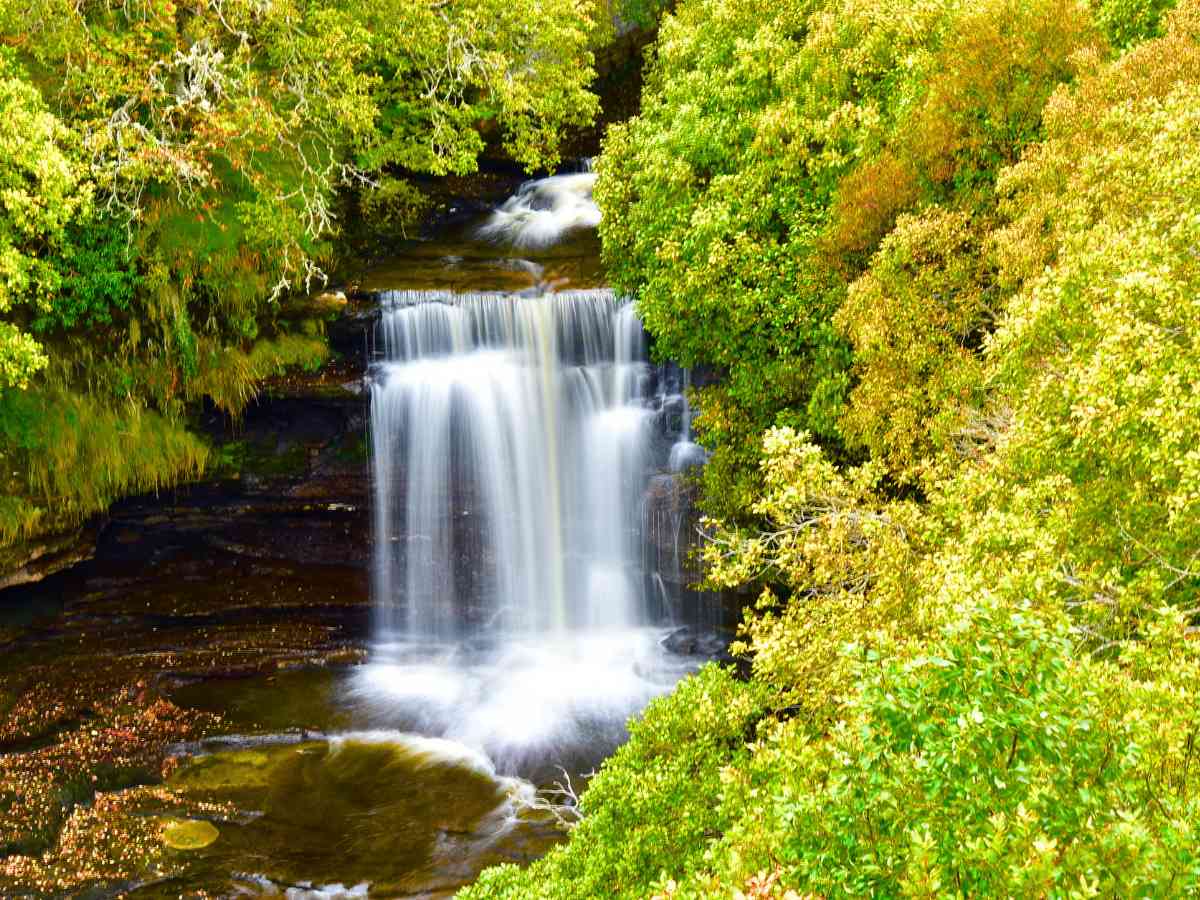
March to May: Spring’s Blossoming Charm
Isle of Skye Weather in March
As March arrives on the Isle of Skye, it ushers in spring, breathing milder weather into the island’s air. This month is characterized by a softening of the winter’s chill, with average temperatures climbing to a more comfortable range of 5°C to 9°C (41°F to 48°F).
The landscape, previously in a deep slumber, begins to stir and awaken, hinting at the rebirth with more frequent sunny days that break through the rain clouds, promising renewal and growth. It’s during this time that the first signs of tourist activity start to emerge, drawn by the appealing combination of awakening flora and the increasing warmth.
March stands as a transitional period on Skye, where the cold retreats and the island dresses itself in the early blooms and fresh greenery of spring. This month offers a diverse and vibrant spectacle that makes it one of the best time to travel to the Isle of Skye, and witness the beginning of its seasonal transformation.
Isle of Skye Weather in April
April on the Isle of Skye is a celebration of spring in full swing, with the island basking in milder weather and reveling in the increased embrace of sunshine. This period marks a delightful shift, with temperatures pleasantly nestled between 6°C to 11°C (43°F to 52°F), nurturing the bloom of wildflowers and the verdant greening of the landscapes.
The extension of daylight hours opens the door to longer adventures, allowing both the island’s residents and its visitors to revel in the natural world around Skye, inviting you to witness the vibrant transformation that encapsulates the essence of spring.
This month is a great time to travel to the Isle of Skye, where the lengthening days and warming weather combine to craft an inviting backdrop for experiencing the island’s renewed beauty.
Isle of Skye Weather in May
May on the Isle of Skye unfurls the island’s springtime magnificence, standing out as one of the driest months and setting the stage for nature’s vibrant showcase. During this enchanting time, temperatures graciously ascend, finding their stride between 8°C to 14°C (46°F to 57°F), thereby enveloping the island in warmth that encourages the full spectrum of flora to burst into a kaleidoscope of blooms.
The longer day-light hours further bless Skye with ample sunlight, illuminating its landscapes in the splendid light of spring and providing you with extended hours to explore and bask in the island’s natural beauty.
May’s combination of mild weather, minimal rainfall, and flourishing life makes it a particularly favoured time to travel to the Isle of Skye. This is especially for those seeking to immerse themselves in the breathtaking vibrancy of the island, as it dresses in its most colourful attire, offering scenes and vistas that are nothing short of mesmerizing.
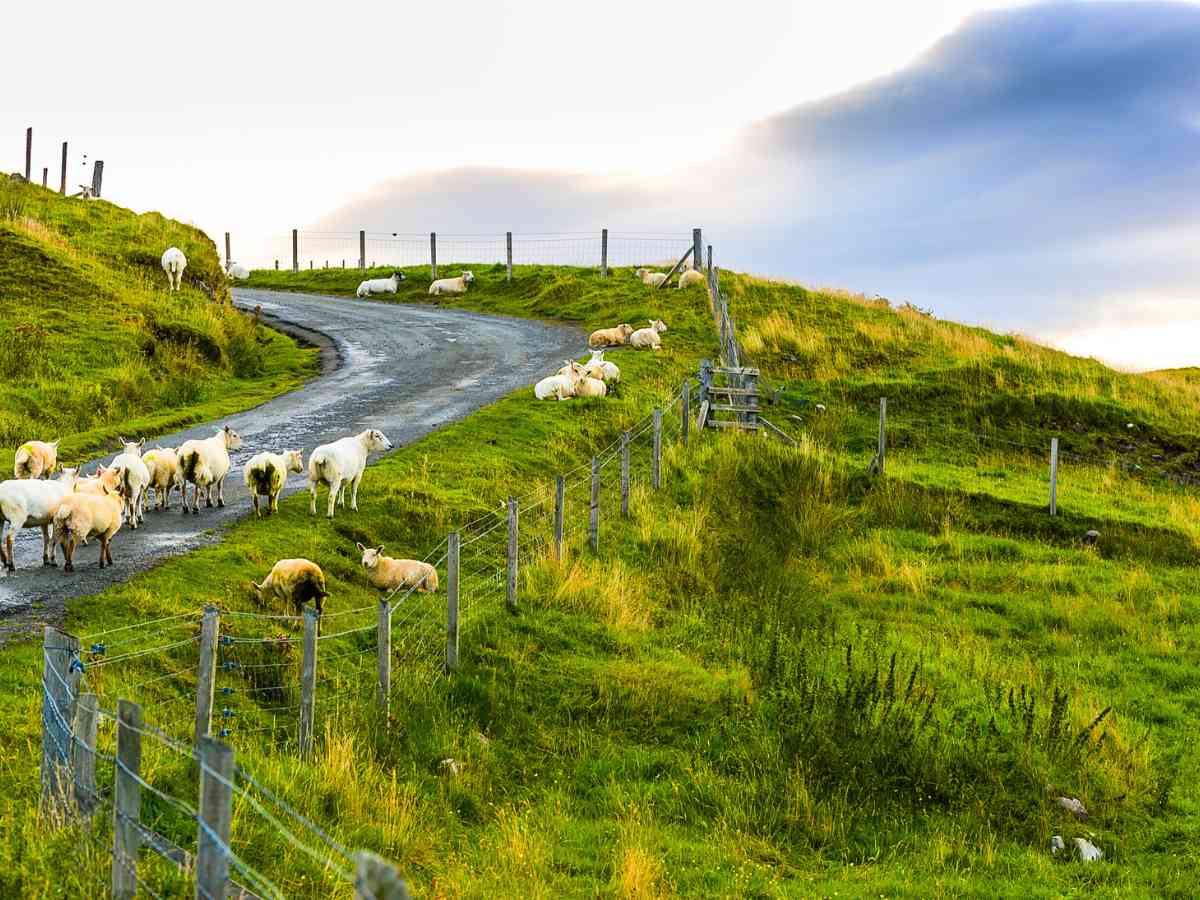
June to August: The Summer’s Vibrant Pulse
Isle of Skye Weather in June
June on the Isle of Skye marks the peak of spring transitioning into early summer, marked by the longest days of the year that stretch wide the possibilities for hiking, camping, and road trips under the generous Scottish sun.
The weather adopts a warm and congenial demeanor, with average temperatures elegantly poised between 10°C to 15°C (50°F to 59°F), creating an ideal climate for adventurers, nature lovers, and photographers alike to roam the island’s diverse landscapes.
It is during this sunny period that the island sees the onset of its peak tourist season, as travellers from around the globe converge to soak in the abundant daylight and the mild, inviting weather.
Weather-wise, June stands as the best month to travel to the Isle of Skye as the island offers endless possibilities for discovery in the extended daylight, while the warm and pleasant climate serves as the perfect backdrop for the myriad of activities that the island has to offer.
However, be aware of midges as this is its best time too. More about midges later in this post.
Isle of Skye Weather in July
July on the Isle of Skye shines as the epitome of summer warmth, inviting you to fully engage with the island’s outdoors. This month is distinguished as typically the warmest, with a welcoming range of temperatures from 12°C to 17°C (54°F to 63°F), ideal for those eager to explore Skye’s trails and natural wonders.
While there’s a chance of rain, it does little to dampen the spirit of adventure, often providing a refreshing contrast to the summer heat. With the sun reigning longer in the sky than at any other time of year, the extended daylight hours open up endless opportunities for exploration on the Isle of Skye.
Embark on a hiking adventure along the Quiraing or ascend the Cuillins. Enjoy the island’s breathtaking landscapes and consider taking boat trips, which can include excursions around Skye or even to the distant shores of the Outer Hebrides for a more expansive exploration.
July’s inviting climate and abundant sunshine mark one of the best seasons for visitors on the Isle of Skye, attracting tourists and outdoor enthusiasts alike. During this prime time, the island vibrates with life, offering an unparalleled opportunity to immerse in its vibrant essence.
From the rugged beauty of its coastlines to the majestic allure of its mountains, Skye becomes a playground for those eager to explore its natural wonders, making it an ideal month for those looking to capture the essence of the island’s breathtaking landscapes.
Isle of Skye Weather in August
August on the Isle of Skye remains warmly embraced by summer’s touch, yet with a gentle nod to the forthcoming autumn as the month progresses. The weather continues to favour the warm side, mirroring the pleasant conditions of July, yet introduces an increased likelihood of rain showers.
These showers serve not as a deterrent but as an enhancer of the island’s lush landscapes, dressing Skye in even more vibrant shades of green and making its natural beauty all the more enchanting.
In August, the Isle of Skye typically experiences temperatures that are similar to those in July, making it one of the warmer months of the year. The temperature range usually falls between 12°C to 17°C (54°F to 63°F). This range provides a comfortable climate for a wide array of outdoor activities, from hiking and sightseeing to enjoying the scenic beaches and coastal areas.
As the month progresses, especially towards late August, there might be a slight decrease in temperatures, signaling the gradual approach of autumn, yet still offering ample warmth for those looking to savour the last of summer’s offerings.
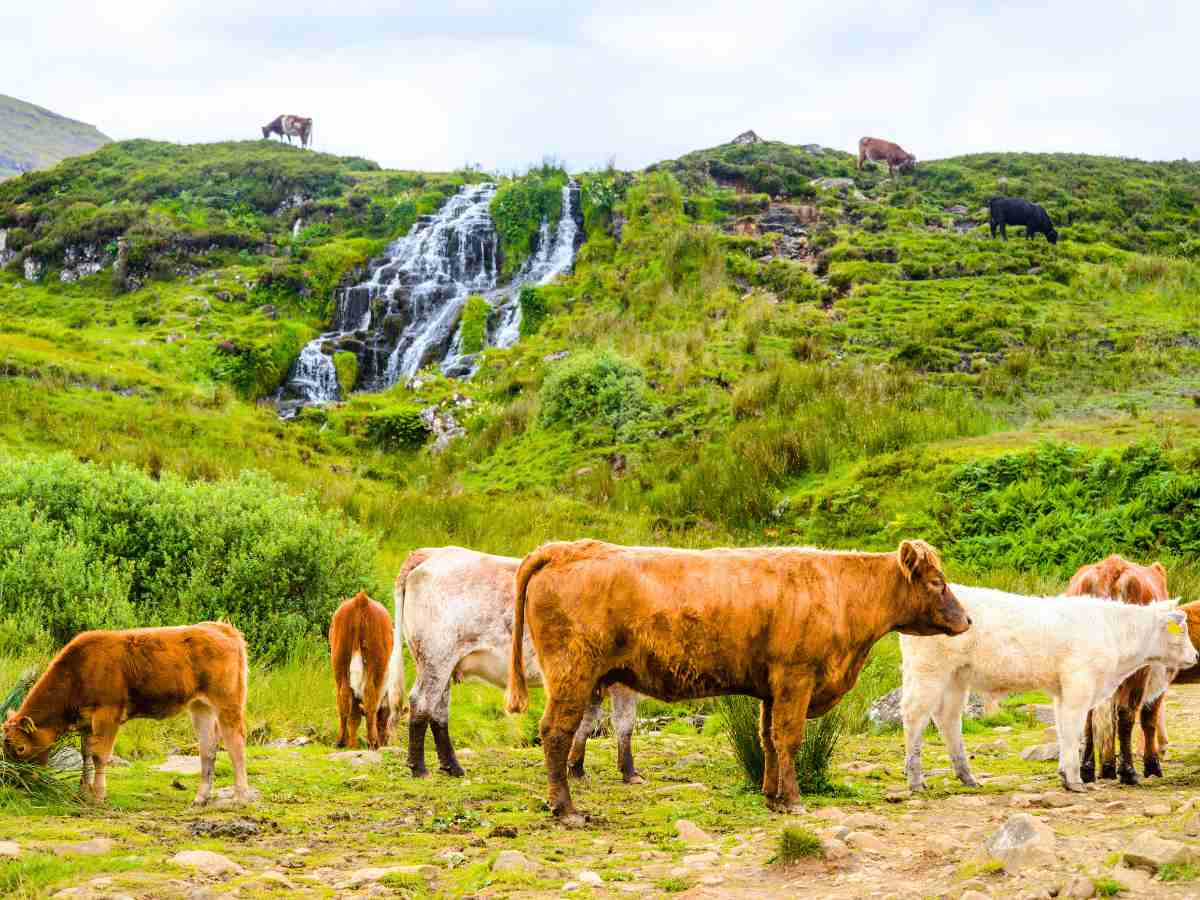
September to November: Autumn’s Golden Hues
Isle of Skye Weather in September
September on the Isle of Skye ushers in the early whispers of autumn, introducing cooler temperatures and a landscape that slowly begins to drape itself in the rich, warm hues of fall. This month marks a gentle shift from the bustling peak of tourist season to a quieter, more serene time of year, one of my favourite seasons to travel.
September is ideal for those seeking a tranquil exploration of the island’s natural wonders, offering the chance to still bask in the warmth of the autumn sunshine. With midges typically departing by mid-September and attractions becoming less crowded, you can enjoy a more intimate experience amidst Skye’s rugged beauty.
Average temperatures during September range from a comfortable 10°C to 15°C (50°F to 59°F), coupled with a decrease in rainfall from the summer months, making it a favourable time for visitors to enjoy the outdoors. The changing season brings a unique charm to the Isle of Skye, with its landscapes transforming under the autumnal palette, offering a new perspective on the island’s enduring allure.
Isle of Skye Weather in October
October marks a time when the Isle of Skye is fully engulfed in autumn‘s embrace, showcasing a vibrant display of golds, reds, and browns across its landscapes. This month brings cooler temperatures, typically ranging from 8°C to 13°C (46°F to 55°F), perfect for donning warm layers and exploring the island’s natural beauty.
The diminishing crowds and longer evenings offer a tranquil setting for experiencing Skye’s stunning vistas, now bathed in the soft, golden light of shorter days. The increased likelihood of rain adds to the mystical allure of Skye, with misty mornings and the crisp air accentuating the rich tapestry of fall colours.
October’s serene beauty makes it an ideal time for photography, leisurely walks through the changing foliage, and enjoying the cozy hospitality of the island as the evenings draw in. For those captivated by the shifting seasons, October on the Isle of Skye is a celebration of autumn’s charm, offering a peaceful retreat into nature’s spectacular transformation.
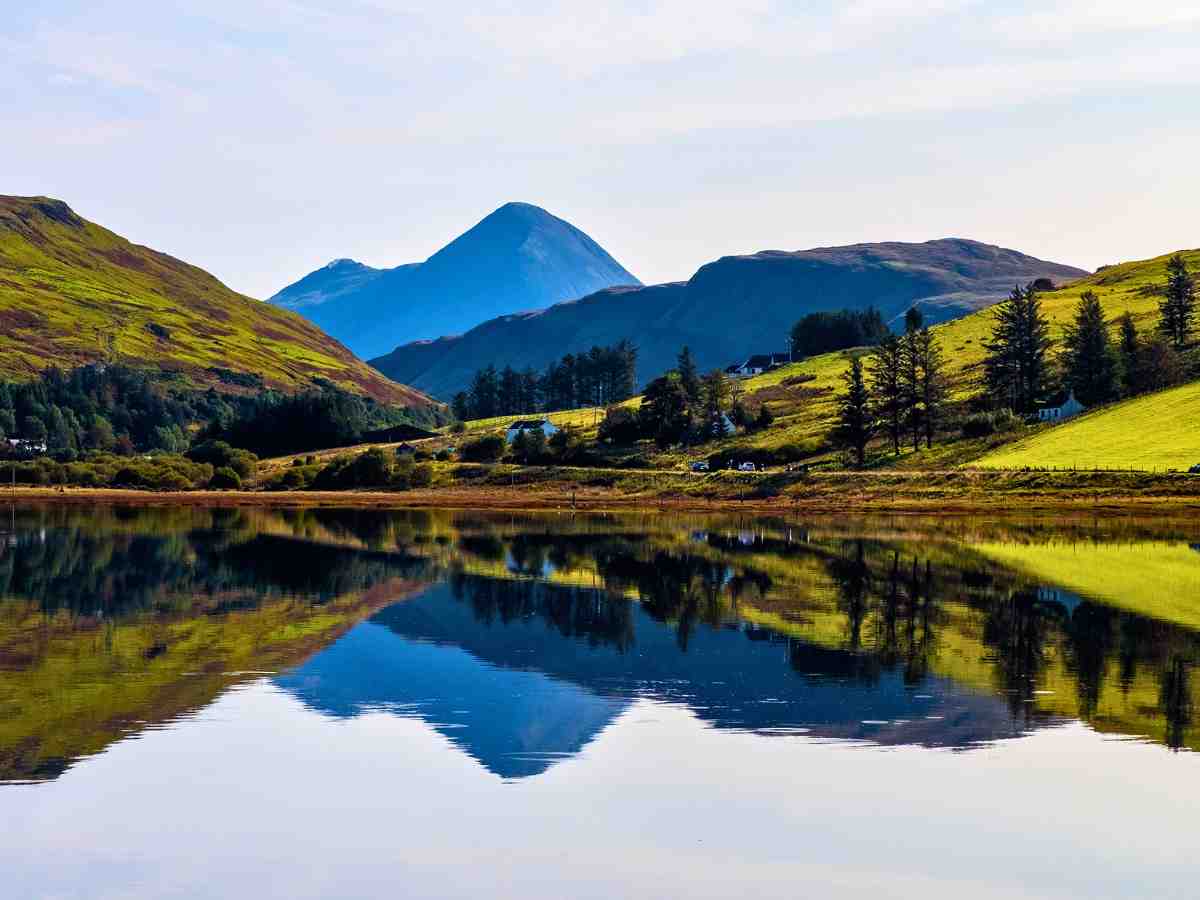
Isle of Skye Weather in November: The Prelude to Winter
As November unfolds on the Isle of Skye, the days shorten and the air chills, setting a serene prelude to winter. This month is characterized by a notable drop in temperatures, averaging between 5°C to 10°C (41°F to 50°F), and a landscape quietly shedding its autumnal cloak in preparation for the colder months ahead.
The diminishing tourist numbers make for a more solitary exploration of the island, allowing for a deeply personal experience of its rugged beauty. November’s cooler days and longer nights invite introspective visits, with opportunities to witness the raw, undisturbed nature of the island.
It’s an ideal time for reflective walks and enjoying the tranquility that precedes the festive season, offering a moment of calm before the winter fully takes hold.
Isle of Skye Weather in December: The Winter’s Embrace
December brings the Isle of Skye into the heart of winter. Temperatures settle between a brisk 3°C to 7°C (37°F to 45°F), and snow graces the higher elevations, painting the landscape in serene shades of white and grey.
This month is marked by the shortest days of the year, creating a cozy atmosphere that is best enjoyed by the warmth of a fire in one of the island’s welcoming local cafes or pubs.
The stark beauty of December’s landscape, combined with the potential for snow-covered scenes, offers a unique charm. It’s a time for bundling up and enjoying bracing walks across the island, where the crisp winter air and stunning vistas invigorate the soul.
As the year draws to a close, Skye’s winter embrace provides a peaceful retreat, with festive lights and holiday cheer adding to the island’s enchanting winter atmosphere.

Some Things to Think About Before Your Trip to the Isle of Skye
When planning your trip to the Isle of Skye, note that the island is a place where nature dictates the pace. Therefore, in addition to the weather guide which I have shared with you, understanding the island’s unique climatic conditions can significantly enhance your visit, allowing you to embrace the full spectrum of its beauty while being prepared for its whims.
Midge Season in Skye: Tips to Stay Bite-Free
The midge season, typically from late spring to early autumn, can be a minor inconvenience in this otherwise idyllic landscape. To stay bite-free, consider using insect repellent, wearing long sleeves and pants during dawn and dusk when midges are most active, and choosing accommodations with midge-proof screens.
READ: A Complete Guide to Midge-Free Areas in Scotland and Steps to Take to Avoid Midge Bites.
Rain and Mist: Embracing Skye’s Mystical Weather
Rainfall and mist are quintessential elements of Skye’s weather, contributing to its lush landscapes and the mystic atmosphere that surrounds its famous landmarks. Donning waterproof clothing and embracing the ever-changing skies can transform your experience, turning what might be seen as inclement weather into an enchanting spectacle.
Wind Speed and Overcast Days: A Closer Look at Skye’s Moods
Skye’s weather is marked by varying wind speeds and frequent overcast days, especially during the cooler months. These elements add a dramatic tone to the island’s rugged terrain, from the wind-swept cliffs to the brooding castles enveloped in mist. Understanding these moods can prepare you for outdoor activities, suggesting the best times to visit specific sites for photography or hiking.
When Does It Snow on the Isle of Skye?
If you are hoping to see Skye with a dusting of snow, the best chance would be to travel in the heart of winter, from December through February.
However, snowfall can vary greatly depending on the year and specific locations on the island. Higher elevations, such as the Cuillin Hills, are more prone to receiving snowfall, even possibly extending into March. In the lower areas, snow is less common and may not settle for long periods.
Overall, the Isle of Skye doesn’t get very cold, especially when compared to mainland Scotland.
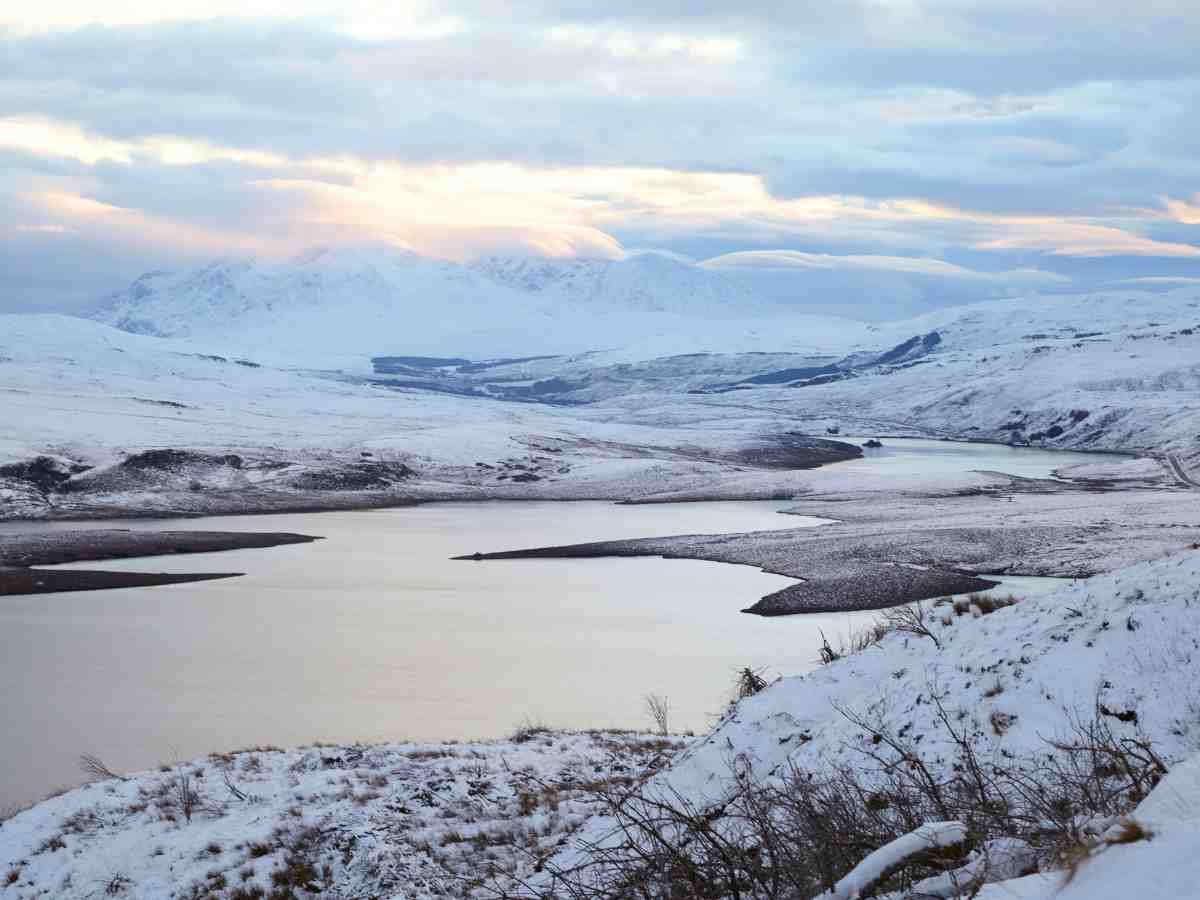
When is the Weather Better and The Absolute Best Time to Visit the Isle of Skye, Scotland
I would say that the weather is better on the Isle of Skye during the shoulder months—May and September—when the weather is relatively mild, midges are not in season, and the major attractions are less crowded.
May is a magical time on the Isle of Skye, marked by vibrant blooms and the absence of midges, making it ideal for exploring the island’s stunning landscapes all-round. With longer, warmer days, soon after winter, you can enjoy the lush valleys and rugged coastlines in peace, before the peak tourist and midge seasons begin. This month offers a perfect blend of natural beauty and comfortable exploration, showcasing Skye at its most serene and beautiful.
And then, there is the month of September, my personal favourite. Drawing from my own experiences of slow travelling in The Highlands, I’ve found that the Isle of Skye reveals its most captivating beauty between mid-September and mid-October. This shoulder season, blessed with milder weather and lesser rainfall, welcomes the autumn sun, whose unique golden glow transforms the landscape into a spectacle of stunning colours.
For an intimate and truly beautiful exploration of Skye, where each scene is enriched by the distinct charm of the autumn sun, I wholeheartedly recommend visiting during these weeks, between mid-September and mid-October. It’s a time that promises not just visual splendour, but a deep, tranquil connection with nature’s wonders.
READ: All about Slow Travel Things to do in: Shieldaig; Fort Augustus, and Loch Shiel.

FAQs
Yes, the Isle of Skye, like much of Scotland, experiences a high level of rainfall throughout the year. Its maritime climate means wet weather is common, with the highest rainfall typically occurring in the winter months.
Skye enjoys a relatively mild climate due to its maritime location, with winter temperatures ranging from 0°C to 5°C (32°F to 41°F) and summer temperatures between 10°C to 15°C (50°F to 59°F), ensuring it never gets very cold.
Skye is renowned for its dramatic landscapes formed by volcanic activity millions of years ago, but it does not have an active volcano today.
The Isle of Skye is surrounded by the Atlantic Ocean. It is located off the west coast of mainland Scotland and is the largest and most northerly major island in the Inner Hebrides.
Yes, dolphins, along with other marine wildlife such as whales and seals, can be spotted in the waters around the Isle of Skye. The best times for dolphin sightings are during the warmer months, from spring through to autumn.
as a deliberate escapist and a mindful wanderer…
Understanding the yearly and monthly averages of temperature, rainfall, and daylight hours can significantly influence your itinerary. By aligning your travel plans with the island’s natural rhythms, you ensure that your experience on the Isle of Skye is not just a visit, but a journey through one of Scotland’s most breathtaking landscapes.
Embrace Skye in all its moods and seasons, and let the island’s dynamic weather be a guide to discovering its hidden gems and spectacular natural beauty. Your adventure on the Isle of Skye awaits, promising memories that will last a lifetime, crafted against the backdrop of one of nature’s most magnificent canvases.
Happy and Safe Travels Always, Wherever Travel Takes You, xx



